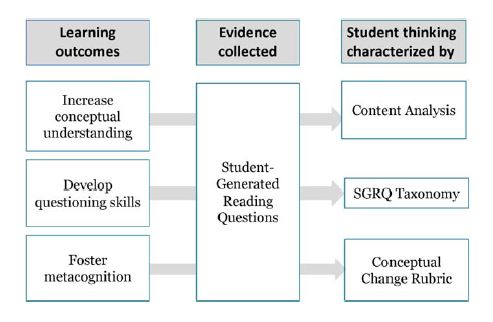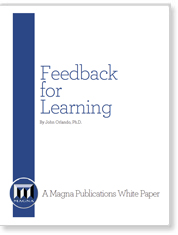Editor’s note: The following is an excerpt from Student-Generated Reading Questions: Diagnosing Student Thinking with Diverse Formative Assessments, Biochemistry and Molecular Biology Education, 42 (1), 29-38. The Teaching Professor Blog recently named it to its list of top pedagogical articles.
Read more ›CURRENT ARTICLE • March 30
OTHER RECENT ARTICLES
Take a moment right now to ask yourself who your best teachers were growing up. Now list the qualities that made them your best teachers.
Read More › "From the way students act at the beginning of a class we can tell a great deal about the profs who taught them previously." It's an insight offered by David Johnson and Roger Johnson, the well-known cooperative learning researchers and advocates.
"From the way students act at the beginning of a class we can tell a great deal about the profs who taught them previously." It's an insight offered by David Johnson and Roger Johnson, the well-known cooperative learning researchers and advocates.
 I am not an athlete. I lack coordination and have some physical limitations. My husband, on the other hand, is an excellent skier. He isn't a teacher but he believed I could learn to ski, convinced me to try, and partnered with me in the learning process, like the best teachers do. Learning to ski taught me 10 coaching strategies bridging four areas: establishing a safe space to learn, sharing responsibility, providing feedback, and empowering the learner. I apply these strategies to facilitating online discussions, but they relate to a range of learning contexts.
I am not an athlete. I lack coordination and have some physical limitations. My husband, on the other hand, is an excellent skier. He isn't a teacher but he believed I could learn to ski, convinced me to try, and partnered with me in the learning process, like the best teachers do. Learning to ski taught me 10 coaching strategies bridging four areas: establishing a safe space to learn, sharing responsibility, providing feedback, and empowering the learner. I apply these strategies to facilitating online discussions, but they relate to a range of learning contexts.
Pedagogy specialists including Armstrong & Hyslop-Margison (2006) support democratic collaborative activities as a positive predictor of student satisfaction. This transfers to online and hybrid (blended) courses. A sense of democratic community within an online course encourages engagement, which can promote higher-level thinking. This raises the question: How can instructors create successful collaborative learning communities online?
Read More › The evidence that students retain content longer and can apply it better when exams and finals are cumulative is compelling. When I pointed to the evidence in a recent workshop, a faculty member responded, “But I can’t use cumulative exams. My students would revolt.” Students don’t like cumulative exams for the very reason we should be using them: they force regular, repeated encounters with the content. And it’s those multiple interactions with the material that move learning from memorization to understanding.
The evidence that students retain content longer and can apply it better when exams and finals are cumulative is compelling. When I pointed to the evidence in a recent workshop, a faculty member responded, “But I can’t use cumulative exams. My students would revolt.” Students don’t like cumulative exams for the very reason we should be using them: they force regular, repeated encounters with the content. And it’s those multiple interactions with the material that move learning from memorization to understanding.
 Nearly every teacher has experienced students forgetting something important. This forgetfulness comes in various forms. It might involve not following instructions for an assignment, missing a due date, forgetting important details on a test, or even forgetting to take the test itself. Whatever the memory infraction, there are usually good reasons why students forget. Gratefully, there are a few simple ways teachers can build context to help students achieve deeper and longer lasting learning.
Nearly every teacher has experienced students forgetting something important. This forgetfulness comes in various forms. It might involve not following instructions for an assignment, missing a due date, forgetting important details on a test, or even forgetting to take the test itself. Whatever the memory infraction, there are usually good reasons why students forget. Gratefully, there are a few simple ways teachers can build context to help students achieve deeper and longer lasting learning.
 “Am I writing to myself?” That’s what I used to wonder when I first started teaching Spanish online a year ago. My learning management system, message boards, and group emails were impersonal and unresponsive—more like writing in my diary than sharing information with my students. I never knew for certain who read and understood my announcements or received an (electronic) handout or assignment directions. In the traditional, on-campus classroom, I’m a very interactive, hands-on kind of instructor, so I also went from knowing each and every one of my students by name and even a little bit about them to having nothing more than a roster with 115 names and majors. I just wasn't satisfied, so I did something that others in the field had encouraged me not to do; I created a Facebook group for the class, and I’m not going back.
“Am I writing to myself?” That’s what I used to wonder when I first started teaching Spanish online a year ago. My learning management system, message boards, and group emails were impersonal and unresponsive—more like writing in my diary than sharing information with my students. I never knew for certain who read and understood my announcements or received an (electronic) handout or assignment directions. In the traditional, on-campus classroom, I’m a very interactive, hands-on kind of instructor, so I also went from knowing each and every one of my students by name and even a little bit about them to having nothing more than a roster with 115 names and majors. I just wasn't satisfied, so I did something that others in the field had encouraged me not to do; I created a Facebook group for the class, and I’m not going back.
 Is it time to change the online learning conversation? The debate about whether online courses are a good idea continues with most people still on one side or the other. Who’s right or wrong is overshadowed by what the flexibility and convenience of online education has offered institutions and students. Those features opened the door, and online learning has come inside and is making itself at home in most of our institutions. No doubt the debate over the value of online learning will continue, but perhaps it’s being judged by the wrong criteria.
Is it time to change the online learning conversation? The debate about whether online courses are a good idea continues with most people still on one side or the other. Who’s right or wrong is overshadowed by what the flexibility and convenience of online education has offered institutions and students. Those features opened the door, and online learning has come inside and is making itself at home in most of our institutions. No doubt the debate over the value of online learning will continue, but perhaps it’s being judged by the wrong criteria.
“The faculty of voluntarily bringing back a wandering attention, over and over again, is the very root of judgment, character, and will. No one is master of himself if he have it not. An education which should improve this faculty would be the education par excellence. But it is easier to define this ideal than to give practical directions for bringing it about.”
William James, (1842 – 1910)
Psychologist, Philosopher
Looking out at our students in classrooms today, with their texting, Facebook updates, Instagram messages, e-mail checking, Google searches, and tweeting, it’s hard to imagine what was so distracting for college students more than 100 years ago when James made this statement. Yet, even then, he recognized the propensity of the mind to constantly seek novel material, to leap from thought to image to belief to fear to desire to judgment and back again — all following one’s own quirky train of thought resembling the chaotic movements of a swarm of bees around a hive. Time passes through a warped dimension when the student finally returns to some semblance of attention, unaware of all the cognitive detours taken between points A and B. And that’s just the internal process, prompted by nothing in particular. How much more distraction is invited by today’s mobile technology?
When the term, “multitasking” first emerged, it was worn as a proud badge of accomplishment, touted as proof of the time-saving, productive, and therefore efficient executive. Now, research consistently shows that multitasking is not associated with peak performance; in fact, the opposite is true. More insidiously, multitasking is like drunk driving. Engaging in it impairs performance while simultaneously giving one the impression that functioning is unaffected or even improved. Furthermore, since the brain can only do one thing at a time, what is experienced as multitasking is actually “rapid task switching,” a challenge for the brain that actually compromises learning (Parry, 2013).
Contemplative Pedagogy
In her groundbreaking books, Mindfulness (1989) and The Power of Mindful Learning (1997), Harvard psychologist Ellen Langer lays the foundation for contemplative pedagogy, an educational model that seeks to cultivate deepened awareness and insight through introspection and mindful self-reflection. Teaching methods of inquiry such as journaling, guided meditation, conscious breathing, silence, and drawing stimulate deeper understanding of the material leading to a more personally meaningful experience of education. According to Tobin Hart, professor of psychology at the University of West Georgia, “Inviting the contemplative simply includes the natural human capacity for knowing through silence, looking inward, pondering deeply, beholding… What we know of learning is that the predominant factor is not merely time on task; it is the quality of attention brought to that task. If our attention is somewhere else, we may have little capacity to be present (Hart, 2004).”
Defining Mindfulness
Jon Kabat-Zinn, the founder of Mindfulness Based Stress Reduction (MBSR) defines mindfulness as “the awareness that emerges through paying attention on purpose, in the present moment, and nonjudgmentally, to the unfolding of experience, moment by moment” (Kabat-Zinn, 2003). Mindfulness meditation is a formal practice that involves regular meditation, intentionally re-focusing on the breath, or some other “anchor,” as one observes and retrieves the wanderings of the mind. Informal mindfulness is the daily intention to apply awareness to everyday activities without attachment or judgment.
At least two decades of neuroscientific and psychological research with adults has confirmed the benefits of mindfulness practices in improving such cognitive processes as working memory, attention, problem solving, and verbal reasoning (Chan, et al, 2008). Just 10 minutes of mindfulness each day has been shown to alleviate stress, boost immunity, decrease pain, lessen anxiety, decrease insomnia, and improve creativity (Schoeberlein David, 2009).
Meditation in the Classroom?
No, not necessarily… but some do. Mindfulness in education, and a great deal of validating research, has been around for several years, particularly in K-12 settings. Research confirms the myriad of benefits to both students and teachers (Poulin et al, 2008; Soloway, et al, 2011). In her book, Mindful Teaching and Teaching Mindfulness (2009), Deborah Schoeberlein David lists the following benefits of mindfulness practices in the classroom:
Benefits for teachers:
- Improved focus and awareness
- Increased responsiveness to student needs
- Enhanced classroom climate
- Improved overall well-being, emotional balance, and stress management
Benefits for students:
- Improved "readiness to learn"
- Strengthened attention and concentration
- Reduced anxiety before testing
- Increased self-reflection and self-calming
Mindfulness: Hitting its Stride in Higher Education
Many colleges and universities throughout the United States have established mindfulness programs and centers on their campuses. They host student mindfulness groups, and conduct workshops for students, faculty, and staff. Many have dedicated silent drop-in spaces for quiet pauses during the day. At these and other campuses, faculty have begun their own mindfulness practices and incorporate both direct and nuanced teaching methods in their classrooms.
You don’t need to be a seasoned meditator and you don’t need special training to get started incorporating mindfulness practices in your classroom. In fact, you don’t even need to teach a mindfulness module to your students, although that would be preferred. Learn some of the basic concepts, maybe complete some training, and then spend a few minutes introducing the concept to your class.
Find ways to illustrate and model focused attention:
- Once in a while, have students sign the attendance sheet using their non-dominant hand. Notice how much focus this demands, and how it feels while doing it.
- Ask students to write at the top of their notes, “If I was going to be distracted by something today during class, it might be ___________________. I choose to set this aside during this class time.”
- When students break into small group discussion, notice and point out how the seating arrangements affect energy flow and feelings of inclusion or exclusion.
- Take your own mindful break to get yourself centered while erasing the board, administering tests, or walking to and from classes.
- Acknowledge your transition process while commuting to and from campus.
- Pay attention to your breathing … especially that exhale part. The exhale is where the magic resides.
References:
Chan, R. C. K., Shum, D., Toulopoulou, T., and Chen, E. Y. H. (2008). Assessment of executive functions: Review of instruments and identification of critical issues. Archives of Clinical Neuropsychology, 23(2), 201-216.
Hart, T. (2004). Opening the Contemplative Mind in the Classroom. Journal of Transformative Education, Vol. 1, January, 2004.
Kabat-Zinn, J. (2003). Mindfulness-based interventions in context: Past, present, and future. Clinical Psychology: Science and Practice. 10(2), 144-156.
Langer, E. (1989). Mindfulness. Boston, MA: De Capo Press.
Langer, E. (1997). The Power of Mindful Learning. Boston, MA: De Capo Press.
Parry, M. (2013). You’re distracted. This professor can help. The Chronicle of Higher Education. March 24, 2013.
Poulin, P. A., Mackenzie, C.S., Soloway, G., & Karayolas, E. (2008). Mindfulness training as an evidenced-based approach to reducing stress and promoting well-being among human services professionals. International Journal of Health Promotion and Education, 46, 35-43.
Schoeberlein David, D. (2009). Mindful Teaching and Teaching Mindfulness. Somerville, MA: Wisdom.
Soloway, G. B., Poulin, A., & Mackenzie, C.S. (2011). Preparing new teachers for the full catastrophe of the 21st century classroom: Integrating mindfulness training into initial teacher education. In A. Cohan & A. Honigsfeld (Eds.), Breaking the mold of pre-service and in-service teacher education (pp. 221-227). Lanham: R and L Education.
Kristin L. Roush is a psychology professor at Central New Mexico Community College.
Read More ›






